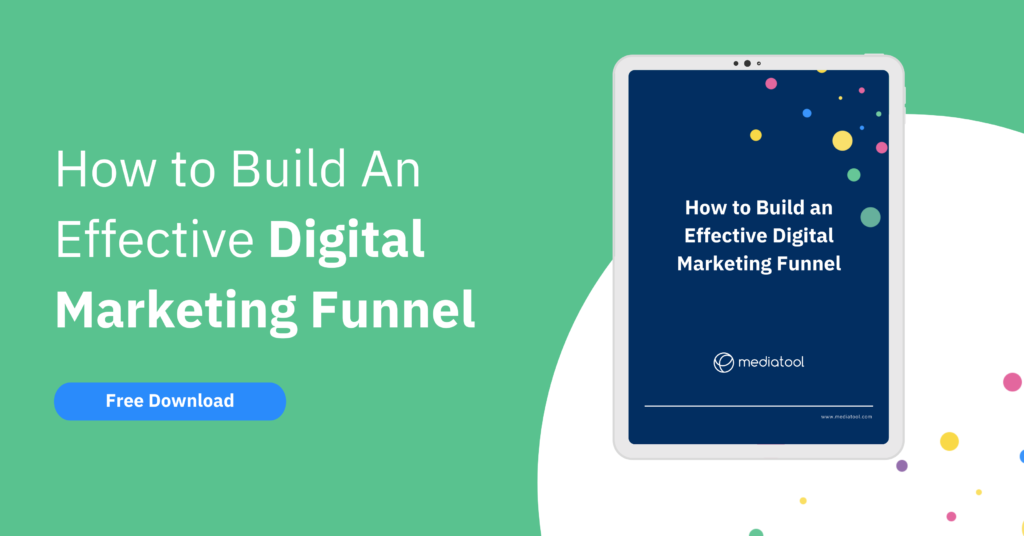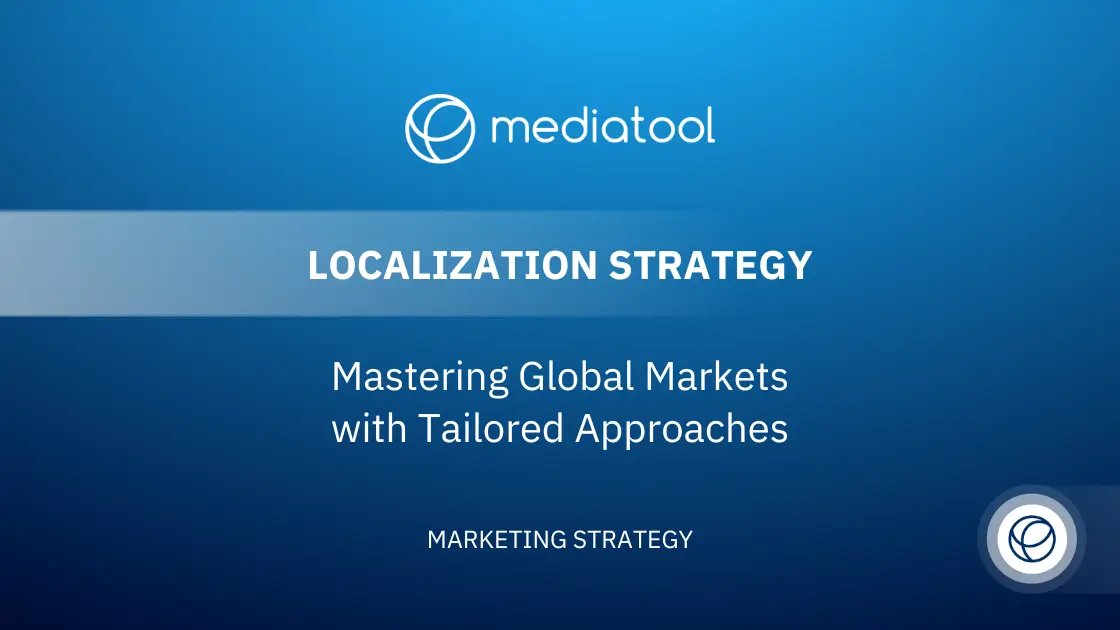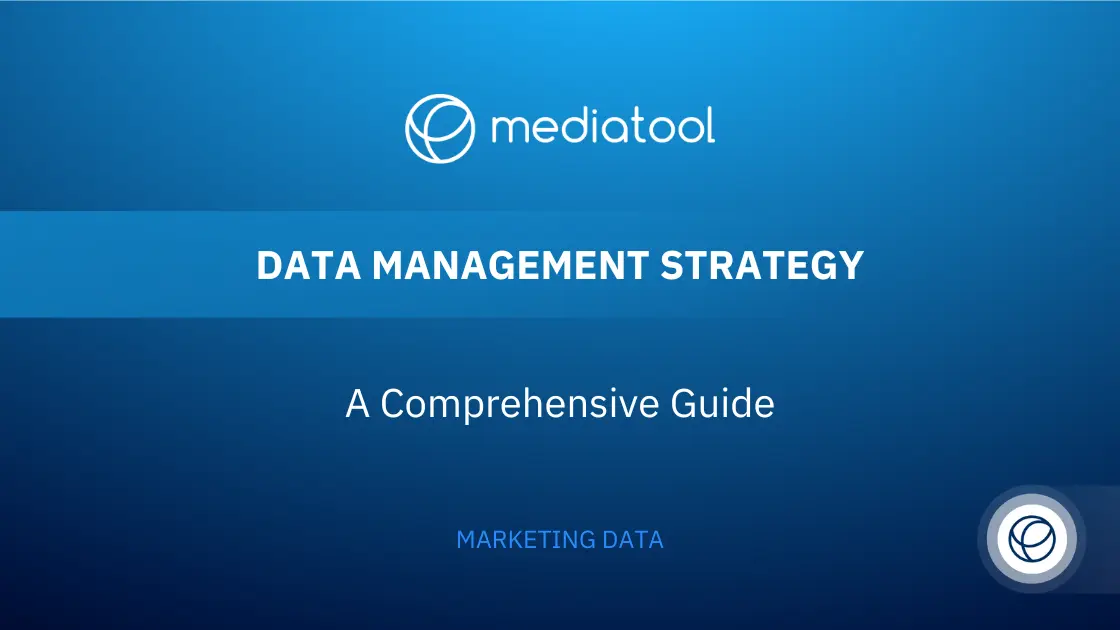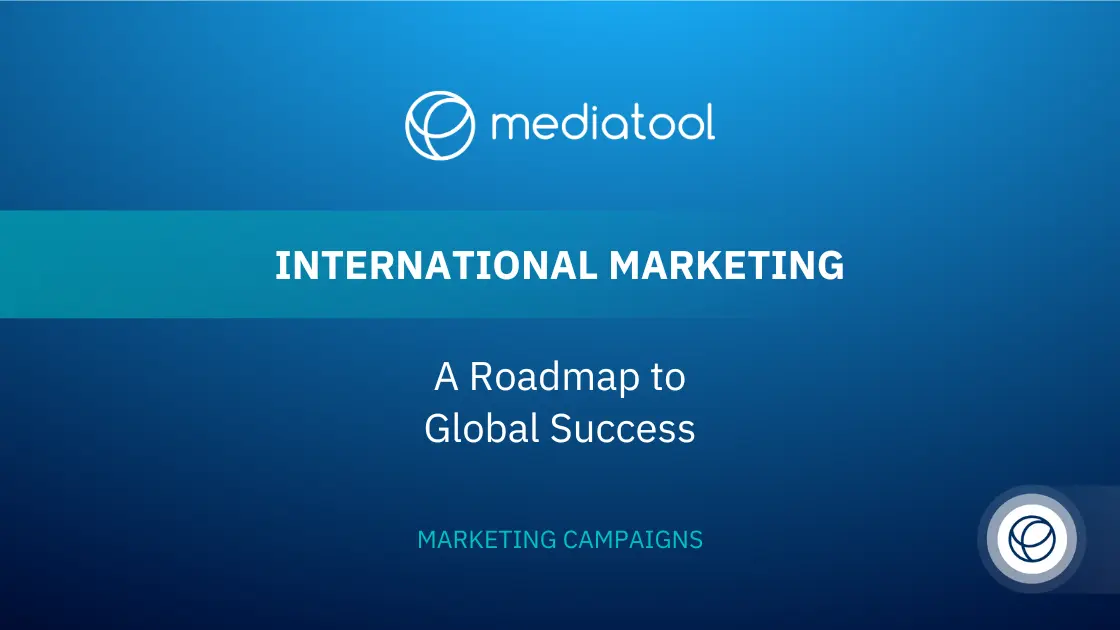Digital marketing funnels vary by brand, industry, and target audience, but they all follow a common framework and there are best practices you can easily implement to optimize your sales and marketing activities.
What route do your leads take to become paying customers? Is your return on ad spend (ROAS) better for Google Ads or Facebook Ads—and what’s your cost per acquisition (CPA)? You may struggle to answer these important questions if you don’t have a highly organized and well-oiled digital marketing funnel.
Marketing without a properly orchestrated digital marketing funnel is a bit like inviting absolutely everyone into your shop, and watching most of them quickly leave because your brand’s just not for them! So, what even is a digital marketing funnel and how do they work? How do they convert visitors into leads into paying customers? Most importantly, how can you optimize your funnel to meet your KPIs and increase sales?
Let’s start by defining what digital marketing funnels are and how they work. Then, we’ll move onto actionable advice to optimize each stage of your funnel to get closer to your target customers, increase sales, and drive growth.
Digital marketing funnels explained
What is a digital marketing funnel (and why is it even a funnel)?
At its simplest, a digital marketing funnel is a framework of touchpoints that sales and marketing teams use to target their ideal audience and convert them into paying customers. Naturally, the number of people at the beginning of the funnel is much greater than those who eventually become customers, so optimizing your funnel at each stage to be as effective as possible is essential.
For example, let’s say you run marketing campaigns for an e-commerce clothing website and a user sees one of your ads for the first time. At this point, they’ve just entered your funnel and they don’t know anything about your brand. Bombarding them with time-limited offers and other high-pressure incentives to hurry up and buy now just won’t do any good. This person doesn’t need a direct sales pitch right now. They’re only just learning your company exists. What they need is education about your brand, its values, and products.
It’s pretty rare to convert a top-of-funnel prospect right away and many marketers still adhere to the rule of seven points of contact, even in the digital age of the online impulse buy. From the top of your funnel right through to the bottom, every single interaction needs to be carefully designed to move a prospect onto the next stage of your digital marketing funnel. Once you understand your funnel, you’ll know what information to present to prospects at each stage, plus you’ll almost certainly get a deeper understanding of how people interact with your brand.
How do digital marketing funnels work?
As we’ve mentioned already, there are various digital marketing funnel stages and the ultimate goal of each stage is to move prospects onto the next until they purchase. The specific components making up each company’s funnel will be different based on industry, target audience, and a brand’s marketing style. But, while there are many different versions of the digital marketing funnel, they almost all follow a standard pattern with five distinct stages:
- Awareness
- Consideration
- Conversion
- Action
- Retention
First, we’ll go through each stage before getting stuck into how to build the ultimate digital marketing funnel.
Digital marketing funnel stages
1. Awareness: discovering your brand for the first time
This is the point when someone first discovers your brand exists, so the main focus for marketers at this stage is to help as many people as possible from your target audience find out about your brand, what products or services it sells, and whether it solves a problem for them. Not all people who enter at the awareness stage will make a purchase, and the ones that do might not be prepared to purchase from you right away. Up to 96 per cent of new site visitors are not ready to purchase on their first visit, so your goal as a marketer is to build up their awareness of your brand and its offering.
Let’s stick with our fashion e-commerce example. In the awareness stage, the marketing manager’s goal is to raise brand awareness among their target audience. To do this, they might choose to run an organic social media marketing campaign to promote their new Summer collection, using Instagram Reels and TikTok trends to attract attention whilst speaking the same language as their audience.
A great real-life example of this is the global e-commerce marketplace Groupon. They put a lot of effort into their awareness campaigns, which include email, content marketing, and social media. As an online marketplace, they have a wide target audience and use the awareness stage to teach people about their brand, whilst also community building. Take this Facebook post, they aren’t selling anything but instead are using topical humour to build community engagement.
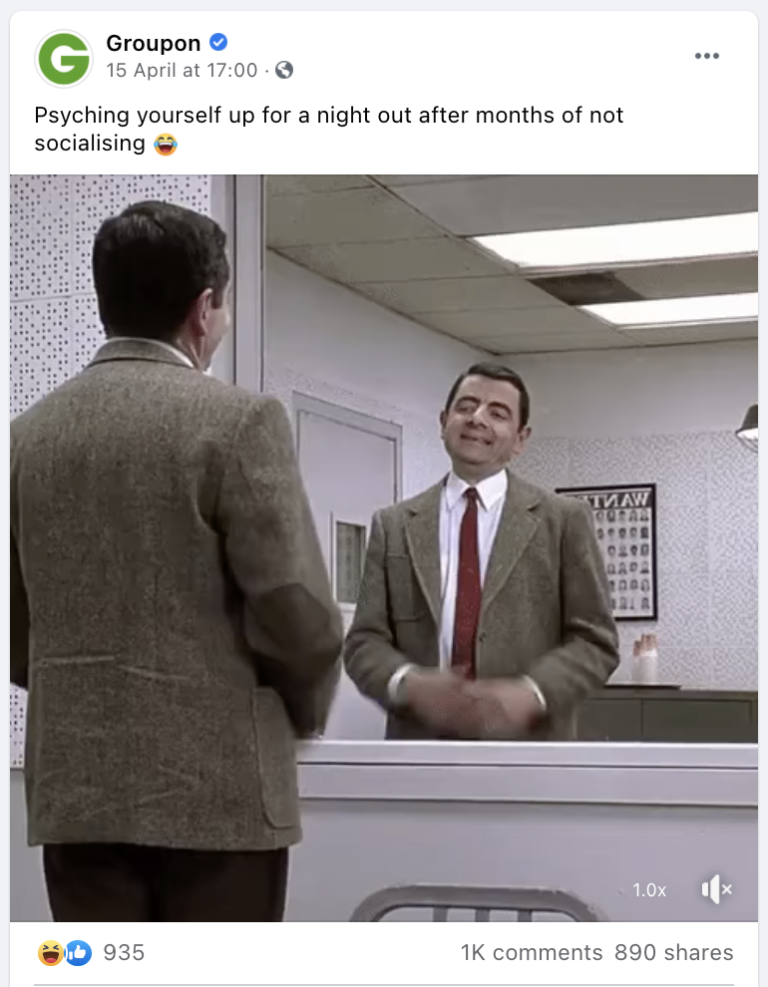
(www.facebook.com/groupon.uk)
2. Consideration: finding that match made in heaven
When an interested visitor moves along your funnel from awareness to consideration they’ve decided to learn more about your company to see if you’re a good fit for them. They’ll spend time digesting content about your brand, its values, and your products. At this stage, it’s all about using your content to build a trusting relationship that potential customers need to progress to the next stage of your digital marketing funnel. What a potential buyer learns about you now will form a powerful and lasting impression on them.
Having a clear tone of voice and brand guidelines are crucial since your potential customers will also be considering how relatable your brand is to them and whether you fit with their values. Remember, whilst considering buying from your company they’re also checking out your competitors. As a marketer you have to work to win them over.
Let’s take a look at our e-commerce clothing and fashion company example. Let’s say for instance an online ad promoting this season’s sportswear and athleisure clothing catches the eye of a potential customer. It piques their interest so they click on the ad and visit the online store: they’ve just moved from awareness to consideration. They’re impressed by the brand but they’re not ready to make a purchase. So, they sign up for the email newsletter and follow the brand on Instagram to learn more and stay up-to-date with new products, offers, and promotions.
Looking again at Groupon, their homepage has a clear and prominent email opt-in pop-up. They’ve been steadily growing their email audience for years and they use email marketing campaigns to encourage people at the consideration stage to convert. It also fits very well into their sales funnel model, which can be thought of as a giant email list which they use to push promotions, offers, and news out to their audience.
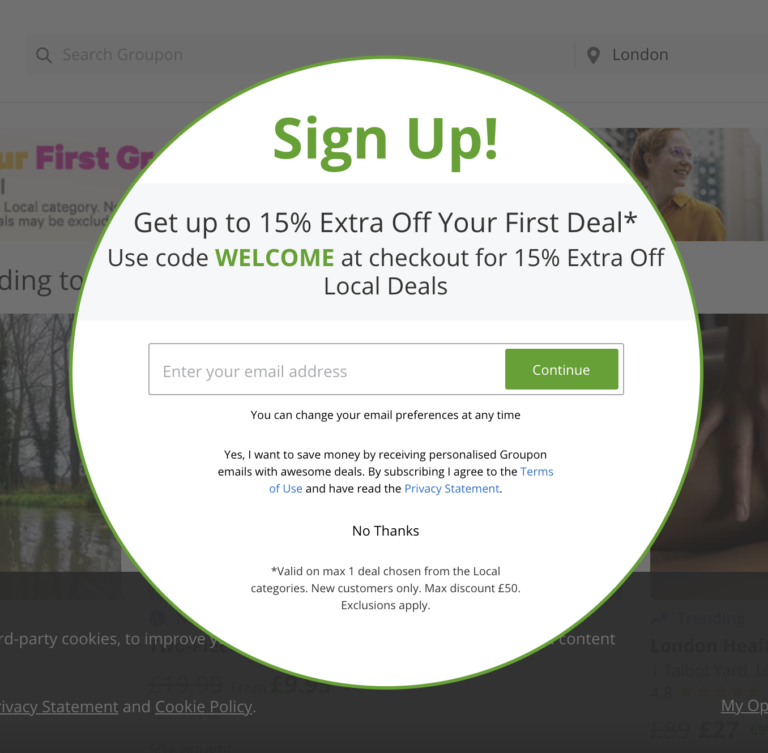
(groupon.co.uk)
3. Conversion: falling in love with your brand
Conversion is the most critical point in the funnel. In this stage, a prospect moves from learning about your company to wanting to buy from you. However, they haven’t purchased anything yet (that’s next), so you have to work to prove your brand and offering are the best match for a potential customer and incentivize that sale.
It’s important to remember that potential buyers will be looking over the finer details at this stage—such as your delivery and returns policies, testimonials and reviews, and key product information. Make sure this information is well thought through and easily accessible to help people decide to purchase from you.
Special offers and discounts, abandoned shopping trolley notifications, and easy account setup are also very important to help make it as fluid an experience as possible for people to buy from you. Remember that if something about your branding goes against someone’s morals they almost certainly won’t buy from you—regardless of how much they are enticed by the product—so it’s a good idea to be upfront and transparent about your key values.
Looking again at our e-commerce clothing and fashion website example, our potential buyer is reading about the company and they feel the brand’s ethical position aligns with their own. They then receive a targeted email about the new spring line opening tomorrow and this incentivizes the sale. Our potential buyer decides to order new running gear tomorrow to help motivate them to get in shape this spring, moving them to a purchase decision.
Looking at Netflix’s model, it’s the most used paid subscriber video streaming service with 72.9 million monthly users, and for good reason. The key information potential buyers need to see before they make a purchase decision is simple, clear, and intuitive. Their homepage uses a progress bar-timeline design to explain the risk-free trial, they clearly state there’s no commitment, and there’s the option to cancel anytime. They also have detailed FAQs where you can scroll right to the section you need, such as pricing and how to cancel.
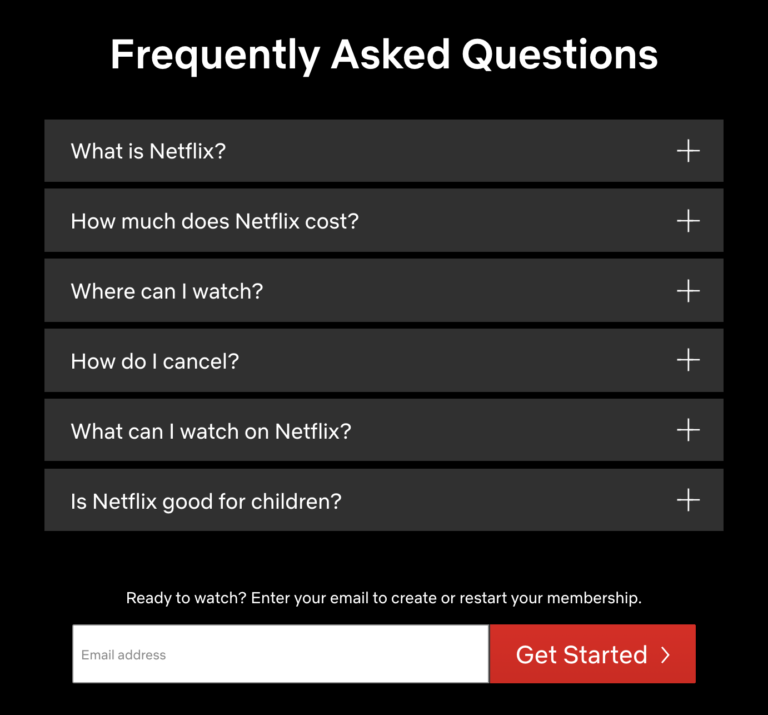
(netflix.com)
4. Action: deciding it’s time to commit
Action is the stage where your prospect purchases from you and becomes a customer. Marketing materials at the action stage should convey urgency, such as time-limited promotions and one-time discounts. This gives a clear reason for someone to act now and not wait.
Remember to counter any last-minute objections to keep potential customers happy and nudge them over the line. Then, once the sale is made, don’t forget to follow up and maintain the relationship to create retention and keep in their good books. They may become a reliable customer for years, so it’s important to keep them on side.
Finally, our e-commerce clothing and fashion website company sweetens the deal by emailing the user again on the day the spring sale launches with an exclusive discount code for a huge saving on purchases over the weekend launch period. This effectively creates a sense of urgency and encourages the person to buy when they intend to.
Looking at Netflix again, the service has a simple and user-focused buying experience. There are multiple payment options like gift cards, credit cards, and PayPal to make it as easy as possible to purchase. Buyers can also go back and edit their information, so they don’t feel like they’re locked in. Netflix also emphasizes security, which is very important especially for people who are new to streaming services.
5. Retention: give customers reason to come back for more
Don’t forget about your existing customers! They’re easier to sell to and cost less to reacquire than people entering your funnel for the first time. Making an effort to convert a customer into a brand advocate (as well as encouraging them to buy from you again) is a very powerful marketing tactic.
At this stage, you should welcome ongoing engagement, give thought to sales aftercare, pursue customer feedback, and consider offering promotion codes to existing customers if they introduce new people to your product or service. An easy win to keep current customers happy is to send them newsletters, updates, and special promotions via email marketing.
Over at our fashion clothing company, our spring sales customer is very happy with their new clothes. This is the perfect time for the brand to reach out with some targeted promotions based on our buyer’s preferences and purchase history, such as products that complement those they’ve bought.
How to build a digital marketing funnel
Now it’s time to go in-depth into each part of the digital marketing funnel and look at the data and metrics, forms of content, and the tactics needed at each stage to help you reach your marketing objectives. This will differ for each brand and target audience, so it’s important to select these carefully to build your marketing plan.
Top-of-funnel: visibility
At the top of your funnel, your one goal is to attract as many people within your target audience as possible.
Content
At this point in the funnel, your goal should be to educate and peak the interest of your target audience. Focus on creating helpful, relatable and topical content instead of being too salesy. Users need to learn about your brand and what you can offer them before they feel comfortable considering whether or not to buy from you.
Top-of-funnel content includes website pages, blog articles, videos, images, animations, and anything that’s easily accessible and provides value to viewers. Remember to keep it light at this stage; your potential buyers will respond well to entertaining content that shows how you can improve their life.
Tactics
As you can probably guess, the tactics at this stage are aimed at attracting viewers and traffic.
Organic social media. Social media is an excellent channel for top-of-funnel activity. Users spend a lot of free time casually browsing and digesting information. Focus on growing your audience through organic engagement and contributing to conversations in existing communities to generate interest in your brand.
Paid ads. Online and offline ads are a great way to attract new visitors. You can carefully target potentially massive audiences via Google, Facebook, Instagram, and Twitter as well as offline channels like TV, radio, print, and OOH (out of home). Make sure you use advanced targeting and segmentation options to reach exactly who you want to on your various channels.
Content marketing. Content marketing is hugely beneficial for inbound marketing and lowering your (CPL) cost per lead over time. It’s essential to have a content strategy that boosts awareness of your brand and answers potential customer questions when they arise. Forms of content might include blogs, videos, and podcasts.
Don’t forget about your SEO! Ranking highly for specific keyword phrases has a huge payoff. It’s not a fast process and a good SEO strategy will take several months to come to fruition. But, when it does, you’ll be ranking on page one for potential customers to find you when they need to and you’ll generate consistent traffic too.
Data and metrics
Website traffic. At the top of the funnel, making sure your site has a high number of visitors may seem like good news, but there are some more important metrics to follow.
Duration of sessions and bounce rates. Longer sessions and fewer bounces are a good indicator of how relevant and engaging your content is and suggests the visitors you’re attracting fit your target audience. A healthy bounce rate varies greatly, but on average you should aim for 41-55 per cent, and if you can lower it to 26-40 per cent, that’s excellent. Sessions averaging three minutes or more are considered healthy.
Proportion of new visitors. You want to keep this metric high to know you’re consistently bringing new people to your site. However, if you’re mostly attracting new visitors this can mean you’re not doing a good job bringing people back to your website. Keeping in mind that the beginning is the largest point in your funnel, 68 per cent is deemed a good average for new website visitors.
Traffic source. It’s crucial to know where your traffic is coming from and what this tells you. For example, if most of your traffic is organic and that organic traffic has better than average bounce rates and session durations, then your SEO strategy is probably working for you. Knowing how your site performs for each traffic source allows you to make decisions based on each channel’s performance. Better yet, use UTM codes to track exactly where your traffic is coming from. In Mediatool you can build custom UTMs for a granular view of your marketing results.
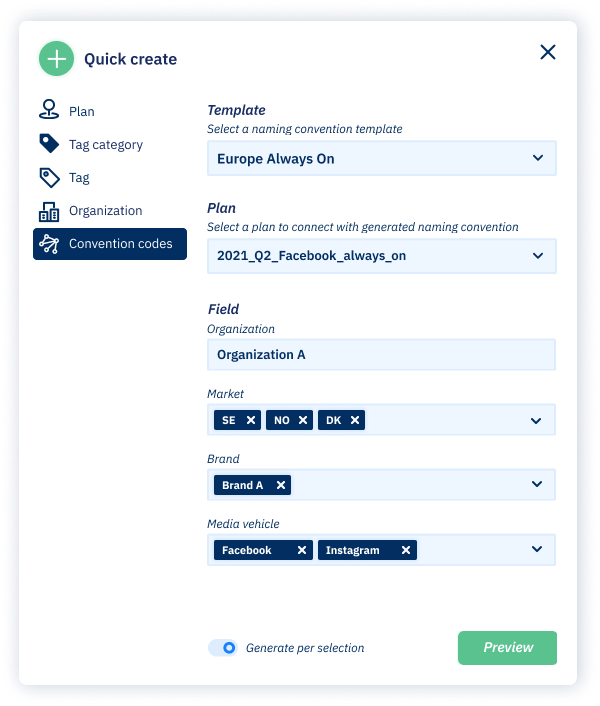
Mediatool’s UTM builder
Ads engagement. Generally speaking, it’s best practice to double down on the channels that are working and de-prioritize those that aren’t. Regularly check your conversion metrics like CPC (cost per click) and CPA (cost per action) to make sure they’re bringing value. It’s also important to review your ad frequency to make sure that your target customers are viewing a healthy mix of your ads without any of them going stagnant.
Social media engagement rate. It’s very important to check how your social media pages are performing over time through your organic efforts. Every social media platform has slightly different metrics, but generally speaking, at the awareness stage it’s important to keep track of your engagement rate. This is a calculation that tells you the level of engagement your posts are receiving. You can then use this to inform your future social media strategy.
Top Tip
Remember there are people behind the numbers and that all marketing is about is creating conversations and connections between people, so aim to create content that speaks to them. Use data to find out more about your target audience, like where they spend their time online, what interests them, and the kind of content they respond to. If you have a clear image of your target personas—and their pain points or purchase motivation—this will help you focus your content and know what metrics to track when it comes to optimizing your top-of-funnel activities.
For example, Innocent smoothies always get applauded for their strong social media marketing and effective community building. How do they do this? By creating relatable social media content that gives potential customers a highly personable and intimate look into their business. Plus, they make great use of different content forms including visual assets that suit their product and target audience.
Got told to make an ad about how you can save 33% on our drinks when you buy them with a meal from @Wasabi_UK. Think we’ve nailed it. https://t.co/ld2pFXmveM pic.twitter.com/437wU3NaGw
— innocent drinks (@innocent) April 19, 2021
Middle-of-funnel: engagement
In the middle of your funnel, it’s all about converting as many top-of-funnel prospects into leads as you can. By capturing a lead (via an email address, for example), you have the opportunity to carefully develop a relationship and build trust between you.
Content
Middle-of-funnel is the place to introduce premium content that builds on your free-to-access content in your top-of-funnel. Here, your content needs to help potential customers develop a strong and lasting impression of your brand and its offering.
Content at this stage is usually gated—meaning it’s available in exchange for some personal information, like an email address. Think of it as an exchange of value. Your potential customers are trusting you with their contact information so they expect something of value in return. Content can include things like lead magnets such as: ebooks, email campaigns, webinars, and masterclasses.
Tactics
Downloadable ebook. Cheat sheets, how-to guides (like this ebook!), checklists, and more: these are simple resources your audience values enough to exchange their email addresses for. To get started, consider combining some of your best-performing pieces of content into an ebook.
Trials, demos, and freemium versions. These are great if you can provide a portion of your product at no cost. By giving you a little of their time, interested customers can experience your offering first-hand to decide if it’s for them.
Events, webinars, and masterclasses. Offering a potential buyer your expert advice and only asking for their time in return is a great way to provide free content or more information about your brand and offering, address questions, concerns, and—of course—put a face to your brand. Plus, the content you create, such as video webinars, can be repurposed as other forms of content, such as made into YouTube videos or podcasts.
Email campaigns. Emails are a direct way to reach your audience, educate them about your offering and present a way for them to move onto the next step of your funnel. From simple welcome emails to monthly round-ups and drip campaigns with exclusive offers, there’s plenty you can do with email marketing. But be mindful of how many emails you’re sending to your leads as too many may see your unsubscribes quickly increase. A lot of marketers choose to set up automated email sequences to help maintain key touch points via email. By using tracking software (like Mediatool!) you can stay on top of your email campaigns and optimize them based on what is and isn’t performing well.
Remarketing. People’s personal opinions on products following them around the Internet are mixed, but remarketing really works. It’s a key part of your mid-funnel marketing and helps warmed up potential customers move further down and finally convert. It’s important to carefully manage your data for remarketing. For example people who have already purchased from you will not look kindly on ads following them around the Internet for the product they’ve just purchased.
Data and metrics
Landing pages. Creating unique landing pages for specific campaigns is an excellent way to track how many people click your links and visit your site. Plus, you can combine your landing page traffic with your actual conversions to see how effective that page is at converting visitors.
View your targets vs your actual results in Mediatool with customizable dashboards, tailored to your team.
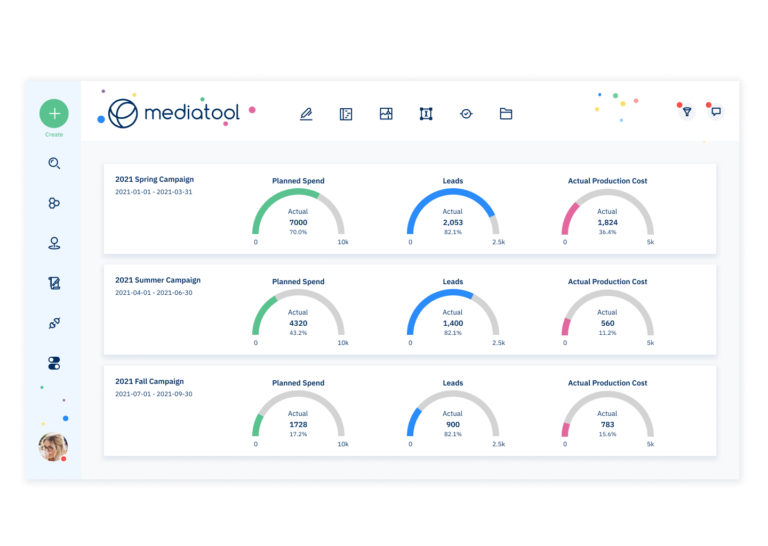
Conversion rates. Use data from your lead forms, pop ups, email sign ups, etc. as an indicator of how attractive your brand and offering are to encourage visitors to become leads. Conversion rates vary greatly by channel and industry, so the best thing to do is to always look for ways to optimize your conversions, like analyzing your website user behavior flow and updating page elements to better entice users.
Email list health. Always keep track of how many email leads you capture in a given period as well as how your general email list health. Keep an eye on your bounces and unsubscribes, as high numbers here can indicate poor email list health. Remember that an expansive email list is one thing but having interested, engaged readers should be your goal.
Open rates, and CTRs (click through rates). Email marketing is a powerful tool to use to build a relationship and develop trust with your audience. The proportion of subscribers who opened an email and how many clicked the links inside are key indicators of success. 15-25 per cent is considered a healthy open rate and 2.5 per cent is an average CTR.
Top Tip
As potential customers progress from top to mid-funnel, it quickly becomes all about your follow-up activities. Personalized emails, targeted remarketing ads, free trials, and freemium access, and more—by following up leads, you’re increasing the potential number of users who’ll purchase from you.
Looking again at Groupon, once you land on their site for the first time you’re hit with their popup inviting you to receive exclusive discounts right in your inbox. Its message is simple, clear, and they’ve been using it for a long time, because it really works!
Bottom-of-funnel: action
This is the moment of truth. When your leads get this far your only goal is to convince them why your product is the right choice and move them to purchase (or repurchase if they are already customers).
Content
Assuming your leads already have the information they need to make a purchase decision, your bottom-of-funnel content focuses on nudging them to make that decision in a timely fashion. Your tactics and content can take many different forms that do this such as sales pages, exclusive offers, discounts, and time-limited promotions.
Tactics
All your tactics at this stage should be geared towards converting leads into paying customers.
Time-limited and limited-stock (scarcity) offers. This is one of the most powerful tactics you can use to acquire customers. Scarcity allows you to add a sense of urgency to a purchase and there are several ways to do this. The most popular ways are to limit availability using time, product units, discounts, or packaged products.
Upselling. Upselling is a great bottom-of-funnel optimization to convince potential customers they’re getting value for money, and it increases your average revenue per customer too.
Bundles. Get your potential customers to create their bundle if you offer several products. When you offer a bundle at a lower price than the individual products, you’re presenting a more compelling offer to your customers and giving them value for money.
Remarketing. Abandoned shopping cart notifications, “complete your purchase” emails, “we haven’t seen you in a while” messages: people fall off your funnel for one reason or another. Remember it’s all in the follow-up and one of the simplest things you can do is to activate simple automated email notifications that gently remind potential customers where they were and invite them to come back and continue their purchase. Remarketing works very well in combination with email captures; use the two together to gently nudge people and move them down your funnel.
Data and metrics
Sales. This may seem obvious but analyzing sales data is important to determine how effective your bottom-of-funnel marketing activities are, and this can help you optimize your tactics. Software that tracks your marketing activities is a great ally to have by your side for maximizing sales and optimizing your budget.
CPA. This should reduce over time as your brand becomes established in new markets and you gain a strong reputation. Moving over to more cost-effective inbound marketing channels also helps, for example reducing your ad spend as your organic traffic steadily increases.
Ratio of new to existing customers. This is a key indicator of how well balanced your marketing activities are. If all your customers are new, then you need to figure out why your previous customers aren’t repurchasing from you for some reason and this pushes your CPA up. Include tactics in your marketing strategy that attract existing customers and ensure there aren’t any issues in aftersales preventing people from buying from you again. Remember the funnel doesn’t end here and it’s important to constantly run retention campaigns to keep your customers coming back.
Total revenue. Again, this seems like an obvious metric, but it’s absolutely critical to compare your actual with your targets to assess your overall performance and see where and how to optimize your spend. If you’re considering using marketing software to help you track your marketing campaigns, check whether you can set your targets and compare them with your campaign progress.
Revenue per customer. You’ll have tiers of revenue to identify different customer groups and average revenue per customer. Consider how to target different revenue per customer groups with specific tactics throughout your digital marketing funnel to increase the chances of getting a healthy balance of revenue per customer group.
Goals and targets compared with actuals. What’s the point in measuring anything without a target or a goal to aim for? Weighing up your planned spend, conversions, budget, etc. against actuals is the crucial benchmark that tells you whether you’re on track, smashing your goals, or you need to urgently steer your campaign in a new direction. It’s a clever idea to check and compare your targets against performance frequently. Make sure your data sources are accurate, reliable, and up-to-date so you can trust the numbers and make changes to get the results you need.
Get an overview of all of your marketing plans and budgets next to your actual performance in one single hub in Mediatool.
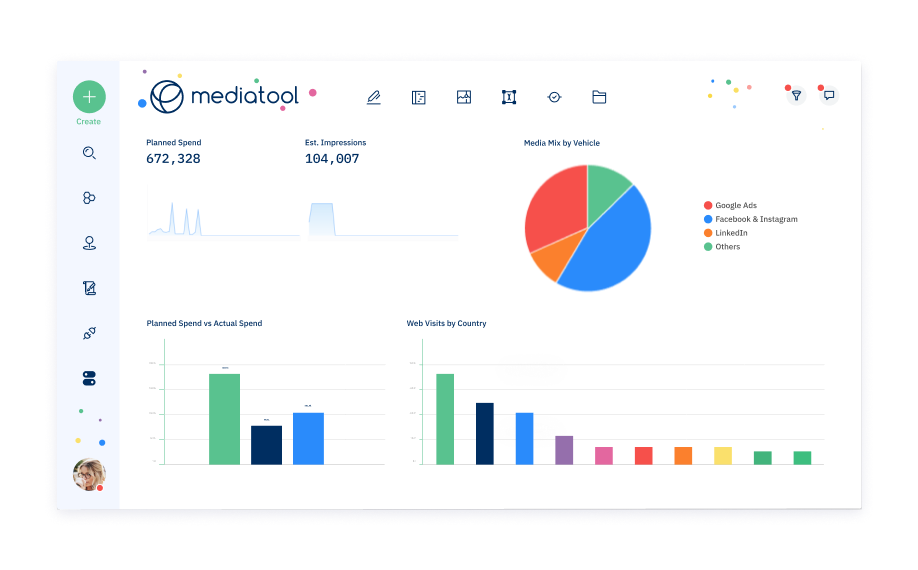
ROI (return on investment). This is one of the most important metrics. Many marketers rely on impressive ROIs to justify their marketing activities to their higher-ups (who, in turn, need to explain them to key stakeholders). Carefully calculate your ROI for both your individual channels and your overall marketing activities. Regularly check them to know how you’re performing against your targets and to be ready to proactively optimize your marketing activities when needed.
ROAS (return on ad spend): not all ads are created equal. While some have the potential to reach millions of viewers (like TV and radio), they may not be best suited for your highly specialized product. Or, perhaps casting your net wide forms that all-important initial awareness stage of your funnel and—although expensive—it’s the key step that leads interested viewers to the next stage.
Top Tip
Don’t forget to appeal to people on a moral level even at this late stage. If your target audience cares about sustainability for instance—but you don’t mention it—this will influence their purchase decision. Or, if your brand suddenly lands in PR hot water and you handle it in a way that isn’t aligned with your target audience’s perception of your brand, they may decide to buy elsewhere.
Finally, don’t forget about your existing customers! Once a lead completes your funnel, they can enter it again. They already know your brand so it’s much easier to resell to them too. Selling to existing customers is a core component of Netflix’s marketing. The streaming platform long held the user retention crown for online streaming services with 74 per cent (until Disney+ recently gained four per cent on them). How does the streaming giant achieve these retention rates? Because they couple CRM data with in-app ads to promote shows based on customer viewing preferences. Coupled with regular updates and new releases, there’s always something new and interesting for users to watch.
Track each stage of your funnel, analyze your data, and optimize your marketing efforts in one place
Mediatool helps you manage your entire marketing campaign from strategic-level decisions involving KPIs, budget, and targets, right down to deciding which specific channels to optimize and adjust your spend on. With its user-friendly dashboard, you can view the data from all your channels and sources in one convenient place alongside your campaign targets, and you can collaborate with your team in-app too.
Mediatool has been specifically designed for brands to manage their global marketing activities as well as agencies to easily manage multiple client campaigns from a central, authoritative source. The best part is you’ve got reliable, accurate, and up-to-date information about your marketing activities so you can be confident you’re making the right decisions to optimize your performance and reach your goals.

Take a platform tour with a member of our team to learn more about how Mediatool can improve your marketing productivity by leaps and bounds!
About Mediatool
So, who are we, the company behind the guide?
Mediatool is a Cloud-based marketing platform that helps brands and agencies to plan, track, collaborate and optimise media and marketing campaigns.
Hundreds of productivity tools for remote teams in a user-friendly interface including: total budget control, seamless data integration, and campaign optimization intelligence for high-performance marketing. Visualize your results to make the data-driven decisions you are not making today.Get a comprehensive overview of all your marketing activities. Everything your team needs to deliver better campaigns, and better results.
